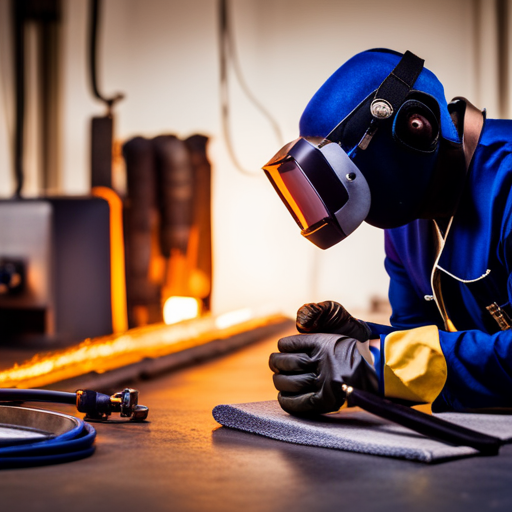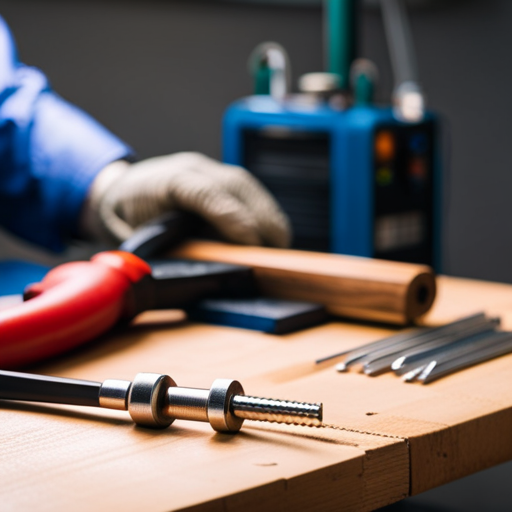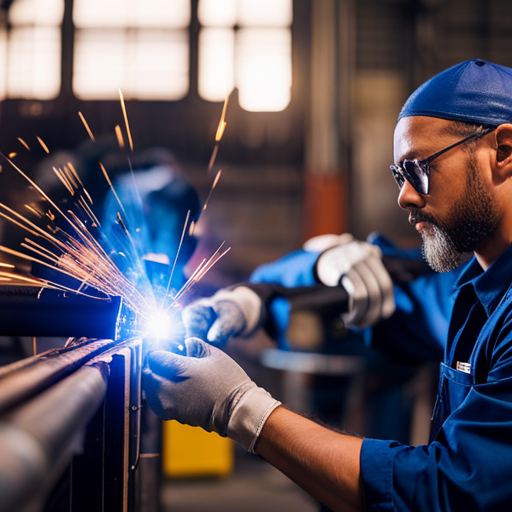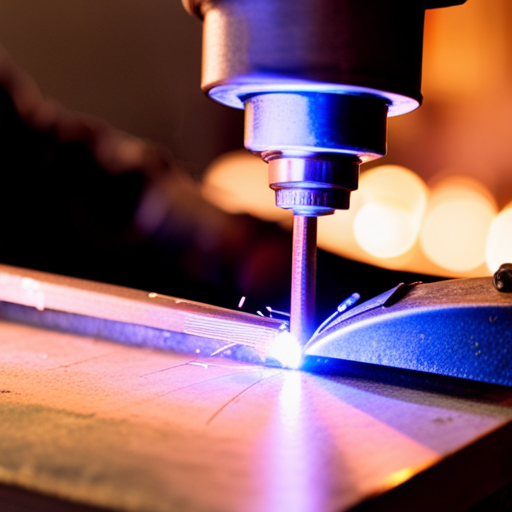Safety Gear Essentials for Upholstery Welding

Discover the paramount importance of safety gear essentials for upholstery welding, where precision and protection are non-negotiable.
Upholstery welding demands meticulous attention to safety, and without the proper protective clothing, equipment, and maintenance, the risks are substantial.
This article delves into the intricacies of eye, face, respiratory, hand, arm, foot, and hearing protection, providing indispensable guidance for ensuring a secure and hazard-free welding environment.
Importance of Protective Clothing
As upholstery welding involves various hazards, the importance of wearing protective clothing cannot be overstated. When selecting protective clothing for upholstery welding, it is crucial to consider the fabric material. The clothing should be made of flame-resistant materials such as leather or heavy cotton to provide a barrier against sparks and molten metal. Additionally, the clothing should fit comfortably to allow ease of movement while still providing full coverage and protection. It is essential to ensure that the clothing fits properly to minimize the risk of snagging or catching on equipment during welding operations.
A comfortable fit is paramount as it allows the welder to focus on the task at hand without being distracted by ill-fitting or restrictive clothing. Properly fitted protective clothing also helps in preventing burns, cuts, and other injuries that can occur during upholstery welding.
Moreover, the clothing should be designed to withstand the rigors of the welding environment, including heat, sparks, and potential exposure to chemicals. By prioritizing fabric material and comfortable fit when choosing protective clothing, welders can significantly reduce the risk of injury and work confidently in upholstery welding operations.
Eye and Face Protection
Protective eyewear and face shields are indispensable for upholsterers involved in welding, as they provide essential protection against hazardous sparks, intense light, and potential projectiles during the welding process. Upholsterers should prioritize the following eye and face protection gear:
-
Welding Helmet: A welding helmet is a crucial piece of protective equipment that shields the welder’s face, eyes, and neck from sparks, heat, and intense light generated during welding. It also provides protection against ultraviolet and infrared rays, which can cause serious eye damage if exposed to for prolonged periods.
-
Protective Eyewear: In addition to a welding helmet, upholsterers should wear protective eyewear, such as safety glasses with side shields or goggles, to guard against flying debris, splashes, and other potential hazards. These safety glasses are designed to withstand high-velocity impacts and provide wrap-around protection for the eyes.
-
Face Shields: Face shields offer an extra layer of protection, covering the entire face to protect against sparks, hot metal, and chemical splashes. They are usually made of impact-resistant materials and are essential for safeguarding the face and eyes from frontal exposure to welding hazards.
It is imperative for upholsterers to use these eye and face protection gear to ensure their safety and prevent potential injuries while welding.
Respiratory Protection
Respiratory protection is crucial in upholstery welding to safeguard against inhaling harmful fumes and particles. The importance of using a filter mask cannot be overstated, as it effectively blocks out hazardous airborne substances.
Additionally, fit testing for respirators is essential to ensure a proper and secure seal for maximum protection.
Filter Mask Importance
During upholstery welding, it is crucial to prioritize respiratory protection by using a high-quality filter mask. When selecting a filter mask, consider the type of contaminants present in the welding fumes and ensure the mask is rated for welding fumes and particulates.
Proper fit is essential, so choose a mask that provides a tight seal over the nose and mouth, with adjustable straps for a secure fit. It’s also important to regularly inspect the mask for any signs of damage or wear, and replace the filters as recommended by the manufacturer.
Proper filter mask usage involves conducting a seal check before each use to ensure a secure fit, avoiding touching the mask while wearing it, and storing it in a clean, dry place when not in use.
Respirator Fit Testing
A proper fit test for respirators is an essential step in ensuring effective respiratory protection for upholstery welding. Fit testing preparation involves ensuring the respirator is clean, in good condition, and properly assembled. Additionally, it’s crucial to conduct a user seal check before fit testing to verify that the respirator is properly seated. Respirator maintenance is also vital for a successful fit test, including regular cleaning, inspection for damage, and proper storage. Below is a table summarizing the key steps for fit testing preparation and respirator maintenance.
| Fit Testing Preparation | Respirator Maintenance |
|---|---|
| Clean respirator | Regular cleaning |
| Check for damage | Inspection |
| Proper assembly | Proper storage |
Hand and Arm Protection
Hand and arm protection is an essential component of ensuring the safety of upholstery welders. When it comes to protecting the hands and arms during welding, glove selection is crucial. Upholstery welders should opt for gloves made from durable and heat-resistant materials such as leather or Kevlar to shield the hands from potential burns and cuts. Additionally, gloves with reinforced palm and finger areas provide extra protection against abrasions and sharp objects commonly found in upholstery workshops.
Wrist support is another key consideration for hand and arm protection. Welding activities often require repetitive hand and arm movements, which can lead to strains and injuries. Using gloves with integrated wrist support or wearing separate wrist braces can help reduce the risk of strains and provide added stability to the wrists during welding tasks.
Furthermore, choosing gloves with a snug and secure fit is essential to ensure proper dexterity and grip while handling welding equipment and materials. Properly fitting gloves also prevent slippage and reduce the likelihood of accidents caused by losing control of tools or workpieces.
Foot Protection
When it comes to upholstery welding, foot protection is essential for ensuring safety in the workplace. Welding boot options provide the necessary coverage and support to protect the feet from potential hazards.
Heat-resistant shoe features are also crucial in safeguarding against the extreme temperatures involved in welding processes.
Welding Boot Options
One essential piece of safety gear for upholstery welding is a pair of welding boots designed to provide adequate foot protection against heat, sparks, and heavy objects. When choosing welding boots, consider the following options:
-
Material: Leather boots offer durability and protection, while rubber boots are often more lightweight and offer better chemical resistance.
-
Toe Protection: Steel toe boots provide excellent impact and compression protection, while composite toe boots are lighter and offer better insulation against extreme temperatures.
-
Sole: Look for boots with heat-resistant and slip-resistant soles to ensure stability and protection on various surfaces.
Selecting the right welding boots is crucial for ensuring the safety and well-being of upholstery welders, as they provide essential protection against potential workplace hazards.
Heat-Resistant Shoe Features
A crucial feature to prioritize when selecting welding boots for upholstery welding is heat resistance, as it ensures effective foot protection against high temperatures and potential workplace hazards. When considering heat-resistant shoe features, it is important to look at various material options, comfort, and durability factors. The table below provides an overview of different material options and their respective comfort and durability factors.
| Shoe Material | Comfort Factors | Durability Factors |
|---|---|---|
| Leather | Offers good breathability and flexibility. | Provides excellent durability and resistance to abrasions. |
| Synthetic | Lightweight with good moisture-wicking properties. | May offer better resistance to chemicals and solvents. |
| Rubber | Offers excellent shock absorption and insulation. | Provides superior resistance to oils and acids. |
| Kevlar | Provides exceptional heat resistance and lightweight comfort. | Known for its high tensile strength and cut resistance. |
Considering these factors will help in selecting the most suitable heat-resistant welding boots for upholstery welding, ensuring both comfort and protection.
Moving on to the subsequent section, it is important to understand the significance of foot protection in upholstery welding.
Importance of Foot Protection
Foot protection is a critical aspect of upholstery welding, with heat-resistant shoe features playing a pivotal role in ensuring the safety and well-being of workers.
When it comes to foot protection in upholstery welding, the following aspects are crucial:
-
Footwear options: Welders need to have access to a variety of specialized footwear options designed to withstand the high temperatures and potential hazards present in welding environments.
-
Safety standards: It’s imperative that the footwear meets or exceeds safety standards for the welding industry to provide adequate protection to the welder’s feet.
-
Comfort and durability: The footwear should not only provide protection but also be comfortable for long hours of wear and durable enough to withstand the demands of the welding environment.
Ensuring the right foot protection is in place is essential to minimize the risk of injuries in upholstery welding.
Moving forward, let’s delve into the significance of hearing protection.
Hearing Protection
The upholstery welder’s hearing protection is essential for safeguarding against the potential hazards of loud noise in the workshop. Prolonged exposure to high levels of noise can lead to irreversible hearing damage. Therefore, it is imperative to utilize effective hearing protection gear. When considering ear protection options, it is crucial to focus on noise reduction to ensure the welder’s safety and comfort. Two common options for hearing protection are earmuffs and earplugs. Earmuffs are designed to cover the entire ear, providing a physical barrier against noise, while earplugs are inserted into the ear canal to block sound. Here’s a comparison of the two options:
| Hearing Protection | Noise Reduction | Comfort Level |
|---|---|---|
| Earmuffs | High | Moderate |
| Earplugs | Moderate to High | High |
Earmuffs offer high noise reduction and are suitable for extended wear, but some users find them less comfortable. On the other hand, earplugs provide varying levels of noise reduction and generally offer higher comfort levels. The choice between the two ultimately depends on the welder’s preferences and the specific requirements of the welding task at hand.
Safety Gear Maintenance
To ensure the longevity and effectiveness of the safety gear, upholstery welders must adhere to a consistent maintenance schedule, inspecting equipment for any signs of wear or damage. Proper safety gear inspection and maintenance are crucial for ensuring the protection of workers during upholstery welding. Here are some key maintenance practices for safety gear:
-
Regular Inspection: Upholstery welders should routinely inspect safety gear for any signs of wear, tear, or damage. Helmets, gloves, goggles, and protective clothing should be checked for cracks, holes, fraying, or any other forms of damage that may compromise their protective capabilities.
-
Cleaning: Safety gear should be regularly cleaned according to the manufacturer’s instructions. This helps to remove any dirt, debris, or chemicals that may have accumulated during use, ensuring that the gear remains in optimal condition.
-
Proper Storage Techniques: When safety gear is not in use, it should be stored in a clean, dry, and well-ventilated area. This helps to prevent damage from environmental factors and ensures that the gear remains ready for use when needed.
Adhering to these maintenance practices will help upholstery welders to prolong the lifespan of their safety gear and ensure maximum protection during welding tasks.
Frequently Asked Questions
What Are the Specific Safety Gear Essentials for Upholstery Welding, and How Do They Differ From Other Types of Welding?
When considering safety gear differences, it’s crucial to highlight the unique aspects of upholstery welding techniques. These include specific protective gear such as fire-resistant aprons, gloves, and respirators designed for working in confined spaces.
Are There Any Specific Safety Precautions or Gear Considerations for Working With Different Types of Upholstery Materials, Such as Leather or Synthetic Fabrics?
When working with different upholstery materials such as leather or synthetic fabrics, specific safety precautions and gear considerations are crucial. Factors to consider include the differences in handling, maintenance schedules, and the challenges of working in tight spaces.
How Often Should Safety Gear, Such as Gloves and Face Shields, Be Replaced or Inspected for Damage in a Upholstery Welding Environment?
Safety gear, such as gloves and face shields, should be inspected for damage regularly and replaced according to the manufacturer’s guidelines. Inspection frequency and replacing schedule may vary based on the type of gear and the intensity of use.
Are There Any Specialized Safety Gear Options or Considerations for Upholstery Welding in Confined Spaces or Tight Areas?
When working in confined spaces or tight areas, specialized equipment is essential to address the unique safety challenges. Consider safety gear options designed for confined area hazards, ensuring protection without hindering maneuverability or obstructing work processes.
What Are the Best Practices for Storing and Maintaining Safety Gear When Not in Use for Upholstery Welding?
When it comes to storing and maintaining safety gear for upholstery welding, it is crucial to keep it in a clean, dry, and well-ventilated area. Regularly inspect the gear for any signs of wear or damage, and follow manufacturer guidelines for upkeep.
Conclusion
In conclusion, it is crucial to prioritize safety when engaging in upholstery welding.
Protective clothing and gear play a vital role in safeguarding against potential hazards. They act as a shield, much like a suit of armor, protecting the welder from various dangers in the workplace.
By consistently utilizing and maintaining safety gear, workers can ensure a secure and healthy environment while carrying out their tasks.

Dillon Hince, an expert in the realm of upholstery welding, brings a wealth of knowledge and experience to the craft. As the driving force behind nodpu.com, Dillon combines a passion for precision and creativity, offering unique insights into the art of seamlessly melding fabrics and materials. With a commitment to excellence, Dillon Hince is your go-to resource for innovative upholstery welding techniques, transforming ordinary pieces into extraordinary works of functional art.





